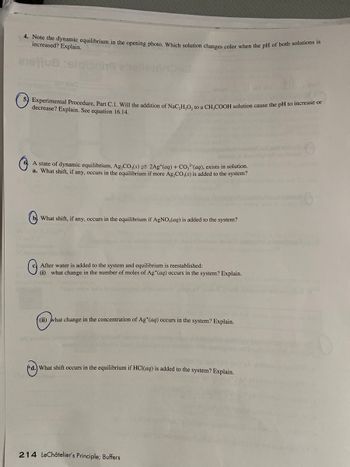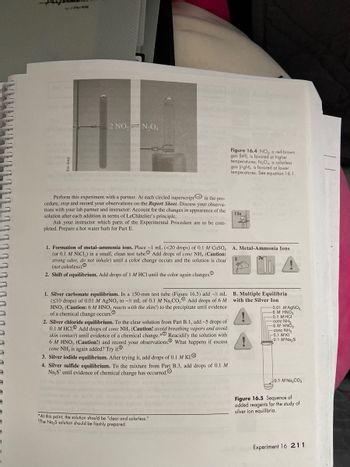
Chemistry
10th Edition
ISBN: 9781305957404
Author: Steven S. Zumdahl, Susan A. Zumdahl, Donald J. DeCoste
Publisher: Cengage Learning
expand_more
expand_more
format_list_bulleted
Question
Provide clear explanation and answers

Transcribed Image Text:4. Note the dynamic equilibrium in the opening photo. Which solution changes color when the pH of both solutions is
increased? Explain.
anottua tek
109d
5) Experimental Procedure, Part C.1. Will the addition of NaC₂H₂O₂ to a CH₂COOH solution cause the pH to increase or
decrease? Explain. See equation 16.14.
G
A state of dynamic equilibrium, Ag₂CO3(s) = 2Ag+ (aq) + CO2(aq), exists in solution.
a. What shift, if any, occurs in the equilibrium if more Ag₂CO3(s) is added to the system?
What shift, if any, occurs in the equilibrium if AgNO3(aq) is added to the system?
G
After water is added to the system and equilibrium is reestablished:
(i) what change in the number of moles of Ag+ (aq) occurs in the system? Explain.
(ii) what change in the concentration of Ag+ (aq) occurs in the system? Explain.
d.) What shift occurs in the equilibrium if HCl(aq) is added to the system? Explain.
214 LeChâtelier's Principle; Buffers

Transcribed Image Text:9
9
9
LV JFROWITE
2 NO₂ N₂O4
hanks
IA allow of DH MOO
Perform this experiment with a partner. At each circled superscript in the pro-
cedure, stop and record your observations on the Report Sheet. Discuss your observa-
tions with your lab partner and instructor. Account for the changes in appearance of the
solution after each addition in terms of LeChâtelier's principle.
Ask your instructor which parts of the Experimental Procedure are to be com-
pleted. Prepare a hot water bath for Part E.
1. Formation of metal-ammonia ions. Place ~1 mL (<20 drops) of 0.1 M CuSO4
(or 0.1 M NiCl₂) in a small, clean test tube. Add drops of conc NH, (Caution:
strong odor, do not inhale) until a color change occurs and the solution is clear
(not colorless).
2. Shift of equilibrium. Add drops of 1 M HCl until the color again changes.
1. Silver carbonate equilibrium. In a 150-mm test tube (Figure 16.5) add ~½ mL
(<10 drops) of 0.01 M AgNO3 to -½ mL of 0.1 M Na₂CO3 Add drops of 6 M
HNO, (Caution: 6 M HNO3 reacts with the skin!) to the precipitate until evidence
of a chemical change occurs.
2. Silver chloride equilibrium. To the clear solution from Part B.1, add -5 drops of
0.1 M HCI. Add drops of conc NH, (Caution! avoid breathing vapors and avoid
skin contact) until evidence of a chemical change.* Reacidify the solution with
6 M HNO, (Caution!) and record your observations. What happens if excess
conc NH, is again added? Try it.
3. Silver iodide equilibrium. After trying it, add drops of 0.1 M KI
4. Silver sulfide equilibrium. To the mixture from Part B.3, add drops of 0.1 M
Na₂S* until evidence of chemical change has occurred.
*At this point, the solution should be "clear and colorless."
The No₂S solution should be freshly prepared.
Figure 16.4 NO₂, a red-brown
gas (left), is favored at higher
temperatures; N₂O4, a colorless
gas (right), is favored at lower
temperatures. See equation 16.1.
13a
A
HOW
A. Metal-Ammonia Ions
B. Multiple Equilibria
with the Silver Ion
-0.01 M AgNO3
-6 M HNO3
-0.1 MHCI
-conc NH3
-6 M HNO₂
conc NH3
0.1 MKI
0.1 M Na₂S
0.1 M Na₂CO3
Figure 16.5 Sequence of
added reagents for the study of
silver ion equilibria.
Experiment 16 211
Expert Solution
This question has been solved!
Explore an expertly crafted, step-by-step solution for a thorough understanding of key concepts.
Step by stepSolved in 3 steps with 2 images

Knowledge Booster
Learn more about
Need a deep-dive on the concept behind this application? Look no further. Learn more about this topic, chemistry and related others by exploring similar questions and additional content below.Similar questions
- Solve correctly please. (Gpt/Ai wrong ans not allowed)arrow_forwardE PAP Chem G diagram sh x H PAP Chemi x G Reactions t x K PAP Chemi: x I PAP Chemi x b ar-2903012.agilixbuzz.com/student/135113422/activity/c412d902-b23e-4202-b813-76alf9f4c196 I Student Ap x Session Tir X Mp Rocking WX Mastery Assess It_8 200% + Reset PAP Chemistry-2903012-42100. Enrique Solis All changes saved 3. Reactions that occur in the gaseous state are affected by changing the volume of the container. Which choice best describes what will happen to the reaction if the volume of the container is decreased? The reaction will speed up. The reaction will shift left. The reaction will not change. SAVE & EXIT NEXT The reaction will shift right. 3 of 25 PREVIOUSarrow_forwardAs pH changes, ho will absorbance change t the wavelength of the isosbestic point?arrow_forward
- Please Help with the Equilibrium Constant & Average Equilibrium. Answer needs to be to 3 significant figures. Please and thank youarrow_forwardi need the answer quicklyarrow_forward← → C view-source:https://... * Question Completion Status: esc blackboard.matc.edu/webapps/assessment/take/launch.jsp?course_assessment_id=_827 QUESTION 9 Choose all acids: ⒸH3PO4 Cu(NO3)2 ☐ Ca3(PO4)2 NH3 KF ! HCI C₂H5OH ☐ H₂SO4 со Li₂SO4 Click Save and Submit to save and submit. Click Save All Answers to save all answers. ← @ 个 #m с THE tA 78 % MD hp Ill & Iarrow_forward
- "OH HCI (conc, aq) 4 products!arrow_forwardX A ALEKS-Allie Fleming - Knowled X + eks.com/alekscgi/x/Isl.exe/1o_u-IgNslkr7j8P3jH-IQUHIQg6bJxmeSyVpHOEB1plef9xyC5Ca9Qlgg70JQ0BkW_S727IDRdmdWICDt8DxedZZpvVEqH-ZDXitxxGhUuDfQ-ZKhas?1 # * 3 E D E Module Knowledge Check Aqueous hydrobromic acid (HBr) reacts with solid sodium hydroxide (NaOH) to produce aqueous sodium bromide (NaBr) and liquid water (H₂O). What is the theoretical yield of water formed from the reaction of 2.4 g of hydrobromic acid and 0.48 g of sodium hydroxide? Round your answer to 2 significant figures. 08 I Don't Know Submit LIZ $ 4 R F 15 % 5 ▬▬ M 16 T G 0.9 6 Q Search X 17 4+ Y H & 7 Ś fa 144 U * fo 8 DII Question 5 - hp fo ( DDI 9 Al J K fm O () © 2023 McGraw Hill LLC. All Rights Reserved. Terms of Use | Privacy Center | Accessibility L 112, insert P { prt sc [ با = () ← } 1 Allie V J BEEN delete olo Ar backspace h enarrow_forwardYellow Dye Calibration Curve y = 254.78x - 0.1414 R? = 0.9792 2.5 1.5 1 0.5 0.002 0.004 0.006 0.008 0.01 0.012 Concentration(M) 3. 2. Absorbancearrow_forward
- (4c-201) Copy the following equation, and label the Bronsted-Lowry acid, its conjugate base, the Bronsted-Lowry base, and its conjugate acid. HNO3 + H2O → H30* + NO3¬ For the toolbar, press ALT+F10 (PC) or ALT+FN+F10 (Mac). BIUS Paragraph Arial 14px A v ... In X2 田由田図 EX: ABC Ť {;} > >arrow_forwardWrite the equation below for the process that occurs when a solution containing HBr reacts with a piece of aluminum metal. Edit View Insert Format Tools Table 12pt v Paragraph v B I U MacBook Pro 80 $ & 4 6. 7 8. E R Y U D F H J K C V M command B *3arrow_forwardhtProblemID=D143793425&offset%3Dnext CHE154-H Gen Chem I Bronikowski S20 ints Part A a solution that is 0.195 M in HC2 H3O2 and 0.100 M in KC2H3 O2 Express your answer to two decimal places. • View Available Hint(s) AZ¢ pH = %3Darrow_forward
arrow_back_ios
SEE MORE QUESTIONS
arrow_forward_ios
Recommended textbooks for you
 ChemistryChemistryISBN:9781305957404Author:Steven S. Zumdahl, Susan A. Zumdahl, Donald J. DeCostePublisher:Cengage Learning
ChemistryChemistryISBN:9781305957404Author:Steven S. Zumdahl, Susan A. Zumdahl, Donald J. DeCostePublisher:Cengage Learning ChemistryChemistryISBN:9781259911156Author:Raymond Chang Dr., Jason Overby ProfessorPublisher:McGraw-Hill Education
ChemistryChemistryISBN:9781259911156Author:Raymond Chang Dr., Jason Overby ProfessorPublisher:McGraw-Hill Education Principles of Instrumental AnalysisChemistryISBN:9781305577213Author:Douglas A. Skoog, F. James Holler, Stanley R. CrouchPublisher:Cengage Learning
Principles of Instrumental AnalysisChemistryISBN:9781305577213Author:Douglas A. Skoog, F. James Holler, Stanley R. CrouchPublisher:Cengage Learning Organic ChemistryChemistryISBN:9780078021558Author:Janice Gorzynski Smith Dr.Publisher:McGraw-Hill Education
Organic ChemistryChemistryISBN:9780078021558Author:Janice Gorzynski Smith Dr.Publisher:McGraw-Hill Education Chemistry: Principles and ReactionsChemistryISBN:9781305079373Author:William L. Masterton, Cecile N. HurleyPublisher:Cengage Learning
Chemistry: Principles and ReactionsChemistryISBN:9781305079373Author:William L. Masterton, Cecile N. HurleyPublisher:Cengage Learning Elementary Principles of Chemical Processes, Bind...ChemistryISBN:9781118431221Author:Richard M. Felder, Ronald W. Rousseau, Lisa G. BullardPublisher:WILEY
Elementary Principles of Chemical Processes, Bind...ChemistryISBN:9781118431221Author:Richard M. Felder, Ronald W. Rousseau, Lisa G. BullardPublisher:WILEY

Chemistry
Chemistry
ISBN:9781305957404
Author:Steven S. Zumdahl, Susan A. Zumdahl, Donald J. DeCoste
Publisher:Cengage Learning

Chemistry
Chemistry
ISBN:9781259911156
Author:Raymond Chang Dr., Jason Overby Professor
Publisher:McGraw-Hill Education

Principles of Instrumental Analysis
Chemistry
ISBN:9781305577213
Author:Douglas A. Skoog, F. James Holler, Stanley R. Crouch
Publisher:Cengage Learning

Organic Chemistry
Chemistry
ISBN:9780078021558
Author:Janice Gorzynski Smith Dr.
Publisher:McGraw-Hill Education

Chemistry: Principles and Reactions
Chemistry
ISBN:9781305079373
Author:William L. Masterton, Cecile N. Hurley
Publisher:Cengage Learning

Elementary Principles of Chemical Processes, Bind...
Chemistry
ISBN:9781118431221
Author:Richard M. Felder, Ronald W. Rousseau, Lisa G. Bullard
Publisher:WILEY